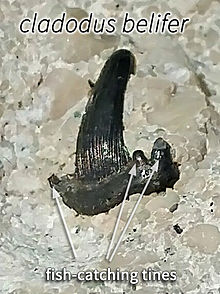133:
20:
80:
367:
160:, was a cladodont existing about 370 million years ago. It had the typical cladodont teeth, which probably also were not regularly replaced like those of modern sharks, but did appear to wear down from use. This shark did indeed appear to swallow its prey whole, fossil examples containing batches of fish arranged tail-first where the shark's stomach should be.
176:
While the earliest known sharks are cladodont, there is some evidence that they evolved from a common ancestor with "diplodonts", sharks whose teeth have two larger blades poking out, plus a small middle tine that could have become the main blade in cladodont teeth.
55:, designed to catch food that was swallowed whole, instead of being used to saw off chunks of meat like many modern sharks. The skinny teeth would puncture and grasp the prey, keeping it from wriggling free.
195:
were thought to be living descendants of cladodonts, but they are now believed to simply be unrelated, curiously shaped sharks, despite similarly pointy, snagging teeth.
259:"New chondrichthyans characterised by cladodont-like tooth morphologies from the Early Cretaceous of Austria, with remarks on the microstructural diversity of enameloid"
411:
445:
404:
397:
211:
119:
51:
shark known primarily for its "multi-cusped" tooth consisting of one long blade surrounded by many short, fork-like
214:: with a comparison between primitive grasping and swallowing, and modern cutting and gouging feeding mechanisms
101:
245:
169:
also begins to appear in the fossil record. Also a cladodont, it survived from the late
Devonian to the early
435:
97:
258:
430:
225:
90:
146:. The roundness of the main tooth, and the small tines around it, show it to be a cladodont.
317:
257:
Feichtinger, Iris; Engelbrecht, Andrea; Lukeneder, Alexander; Kriwet, Jürgen (2020-07-02).
8:
321:
377:
286:
343:
335:
278:
52:
290:
385:
325:
270:
184:
period, based on cladodont teeth found in deep water deposits of Early
Cretaceous (
132:
274:
304:
Guinot, Guillaume; Adnet, Sylvain; Cavin, Lionel; Cappetta, Henri (2013-10-29).
440:
381:
424:
339:
282:
192:
170:
165:
59:
347:
156:
306:"Cretaceous stem chondrichthyans survived the end-Permian mass extinction"
374:
185:
330:
305:
181:
104: in this section. Unsourced material may be challenged and removed.
29:
256:
19:
180:
Some cladodonts appear to have been in existence as recently as the
142:, which lived about 260,000,000 years ago in what would someday be
79:
143:
138:
48:
63:
40:
151:
44:
24:
366:
246:
Physiology of
Elasmobranch Fishes: Structure and Interaction
303:
422:
62:fish is teeth, this term is also used for the
405:
47:) is the term for a common category of early
58:Because the most common fossil evidence of
412:
398:
329:
173:, dying out about 320 million years ago.
120:Learn how and when to remove this message
131:
23:This is a typical Cladodont tooth, of a
18:
423:
446:Prehistoric cartilaginous fish stubs
361:
102:adding citations to reliable sources
73:
16:Early Devonian shark tooth structure
212:Tooth retention in cladodont sharks
13:
223:
217:
14:
457:
365:
78:
89:needs additional citations for
297:
250:
239:
205:
1:
275:10.1080/08912963.2018.1539971
198:
188:) age in Austria and France.
384:. You can help Knowledge by
39:(from Latin cladus, meaning
7:
10:
462:
360:
69:
43:and Greek Odon, meaning
147:
33:
373:This article about a
310:Nature Communications
135:
22:
136:The fossil tooth of
98:improve this article
436:Early Devonian fish
322:2013NatCo...4.2669G
150:The earliest known
378:cartilaginous fish
331:10.1038/ncomms3669
263:Historical Biology
224:Martin, R. Aidan.
163:Around this time,
148:
66:teeth themselves.
34:
393:
392:
130:
129:
122:
453:
414:
407:
400:
369:
362:
352:
351:
333:
301:
295:
294:
254:
248:
243:
237:
236:
234:
233:
226:"Ancient Sharks"
221:
215:
209:
139:Cladodus belifer
125:
118:
114:
111:
105:
82:
74:
461:
460:
456:
455:
454:
452:
451:
450:
431:Devonian sharks
421:
420:
419:
418:
358:
356:
355:
302:
298:
255:
251:
244:
240:
231:
229:
222:
218:
210:
206:
201:
126:
115:
109:
106:
95:
83:
72:
17:
12:
11:
5:
459:
449:
448:
443:
438:
433:
417:
416:
409:
402:
394:
391:
390:
370:
354:
353:
296:
269:(6): 823–836.
249:
238:
216:
203:
202:
200:
197:
193:frilled sharks
191:At one point,
128:
127:
86:
84:
77:
71:
68:
15:
9:
6:
4:
3:
2:
458:
447:
444:
442:
439:
437:
434:
432:
429:
428:
426:
415:
410:
408:
403:
401:
396:
395:
389:
387:
383:
379:
376:
371:
368:
364:
363:
359:
349:
345:
341:
337:
332:
327:
323:
319:
315:
311:
307:
300:
292:
288:
284:
280:
276:
272:
268:
264:
260:
253:
247:
242:
227:
220:
213:
208:
204:
196:
194:
189:
187:
183:
178:
174:
172:
171:Carboniferous
168:
167:
166:Stethacanthus
161:
159:
158:
153:
145:
141:
140:
134:
124:
121:
113:
110:November 2016
103:
99:
93:
92:
87:This section
85:
81:
76:
75:
67:
65:
61:
60:cartilaginous
56:
54:
50:
46:
42:
38:
32:
31:
26:
21:
386:expanding it
372:
357:
313:
309:
299:
266:
262:
252:
241:
230:. Retrieved
219:
207:
190:
179:
175:
164:
162:
157:Cladoselache
155:
149:
137:
116:
107:
96:Please help
91:verification
88:
57:
36:
35:
28:
375:prehistoric
316:(1): 2669.
228:. ReefQuest
186:Valanginian
425:Categories
232:2006-09-09
199:References
182:Cretaceous
64:fossilised
30:Glikmanius
340:2041-1723
283:0891-2963
37:Cladodont
348:24169620
291:92392461
144:Illinois
49:Devonian
318:Bibcode
70:History
27:called
346:
338:
289:
281:
41:branch
441:Teeth
380:is a
287:S2CID
152:shark
53:tines
45:tooth
25:shark
382:stub
344:PMID
336:ISSN
279:ISSN
326:doi
271:doi
100:by
427::
342:.
334:.
324:.
312:.
308:.
285:.
277:.
267:32
265:.
261:.
154:,
413:e
406:t
399:v
388:.
350:.
328::
320::
314:4
293:.
273::
235:.
123:)
117:(
112:)
108:(
94:.
Text is available under the Creative Commons Attribution-ShareAlike License. Additional terms may apply.

